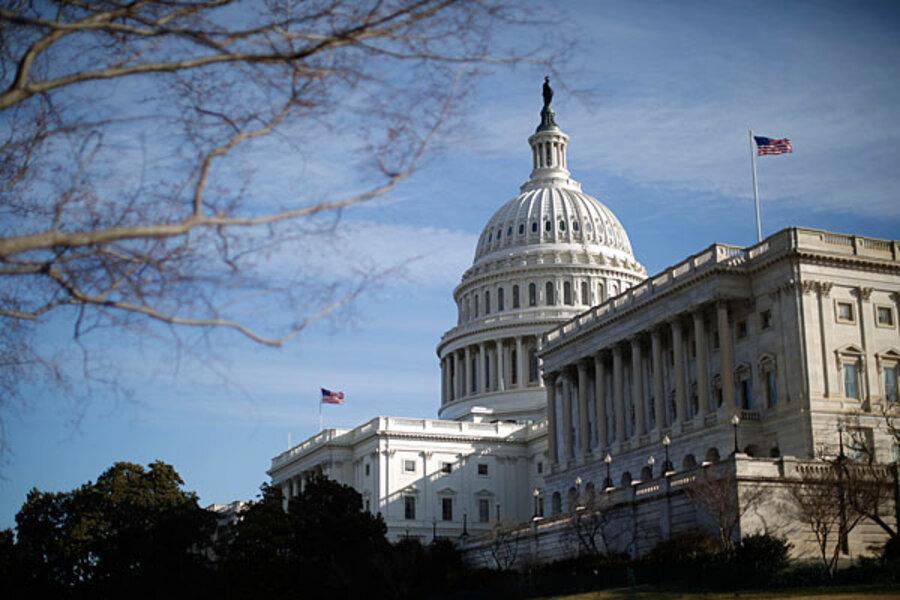What Congress has to do to avert a late-March government shutdown
Loading...
| Washington
If a government shutdown occurs in March, it will be Mother Nature's doing, not Congress's, leaders in both political parties stressed on Tuesday.
As the D.C. region braced for snowfall that could tip into double-digit inches, House and Senate party leaders said both sides share a commitment to avoid a government shutdown and to keep the government running after March 27 (when current funding authorization ends), although the contours of a final budget deal remain hazy.
Failure to reach agreement, they acknowledge, would only add to any economic disruption stemming from automatic budget cuts that will begin biting at month’s end. There’s even a decent chance that along the way Congress could mitigate the worst bite of the "sequester" (as the automatic spending reductions are known).
A dose of congressional responsibility, perhaps?
“There's a sense of urgency and cooperation on both sides to try to get this done,” said Senate minority leader Mitch McConnell, speaking of government-funding legislation during his weekly talk with reporters.
What will Congress have to get done? Two parallel but interconnected issues are roiling Capitol Hill right now. The first is the sequester, more than $1 trillion in spending cuts over the next decade that saw its first $85 billion installment begin on March 1. The second is the need to fund the federal government beyond March 27, when legislation keeping the federal bureaucracy churning comes to an end.
Because the politically controversial sequester affects the level of government spending, these two issues are logically joined at the hip. Yet the leaders shepherding government funding bills on both sides of the Capitol – House Appropriations Committee head Hal Rogers (R) of Kentucky and Senate Appropriations chairman Barbara Mikulski (D) of Maryland – are fighting like mad to keep the toxic politics of the former from affecting the latter.
“This bill has to focus on funding levels,” Senator Mikulski told reporters just outside the Senate chamber, deflecting a question about whether she would add to her forthcoming legislation provisions such as unfreezing government pay, favored by President Obama. “If we keep our focus on the fact that this is not to deal with all the pent-up demand [for various policy additions and instead] keep it as simple, as clear, and as straightforward as we can,” the measure will succeed, she said.
What could muddy the waters? In the House, a crew of conservative Republicans led by Rep. Tim Huelskamp (R) of Kansas sent a letter to GOP leaders asking for the House government funding bill to defund parts of Mr. Obama’s health-care reform law. In the Senate, Democratic lawmakers are queasy about acquiescing to indiscriminate cuts in social programs and domestic priorities, Mikulski said.
Both Mikulski and Rogers have opted to accept to the reality of the sequester by writing legislation that does not alter the amount of cuts to come.
Instead, leaders in both chambers (which include Senate majority leader Harry Reid (D) and Senate Republicans including Mr. McConnell and the Appropriations Committee's Richard Shelby of Alabama) are discussing how much money can be moved around within the budgets of the Pentagon, veterans affairs, border security, government research, and social programs to mitigate the worst of the sequester cuts.
The House bill, expected to pass on Wednesday, primarily protects the federal budget accounts that fund military operations and maintenance, and veterans programs. In addition, the Rogers bill provides extra protection to ensure the safety of nuclear weapons stockpiles, money to fight wildfires in the West, and funds for embassy security and border security personnel.
McConnell said he expected Democrats to put their “imprint” on the House-passed measure. Indeed, Mikulski appears ready to do that in the days to come.
“The content [of the House bill] is too spartan for us because it does not include [flexibility for] domestic priorities,” Mikulski said Tuesday.
What’s unclear is what, exactly, Mikulski will try to safeguard – and whether her tweaks can achieve enough GOP support to overcome a potential filibuster.
“We don’t have a framework,” she said. “What we do have is a will.”
That same will was not evident in 2012’s bitterly partisan, election-year session of Congress, meaning there's no consensus on policy and spending changes for most government spending this fiscal year. Lawmakers did reach accord on a Pentagon spending bill and on authorization for veterans programs and military construction, so those changes have been adapted into the House government funding resolution.
But for the vast majority of the federal government’s operations, time is too short between Tuesday and March 27 for lawmakers to hammer out a comprehensive compromise. That means the sequester cuts, decried by members of both parties during the campaign, will hit nearly all government functions, despite the efforts of Rogers and Mikulski.
“In so many ways, our failure to do our work is catching up with us,” says Sen. Roy Blunt (R) of Missouri. “Many of our government agencies, because of no appropriations bills and continuing resolutions, are working on priorities that were their priorities two, three, four years ago.”







